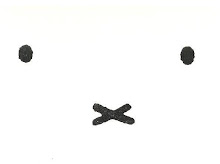慈悲,丁兆麟
Title: Compassion
Calligrapher: Chao-lin Ting, age 97.
I stopped by my dad's place a couple days ago, which is also his workshop where he frames many of my grandfather and grandmother's artistic pieces. My grandfather is a calligrapher and my grandmother paints traditional Chinese watercolor paintings. I'm really proud of their achievements and hope that I can too become a recognized calligrapher or painter one day. :)
I sat with my dad sipping tea as he unfurled a New York City bicycle map and started plot our Next Great Bike Ride. My 19 lb. cat-child, Xiao-hu (小虎), contently settled in on my lap with heavy eyes. My family expresses disbelief that temperamental Xiao-hu still recognizes me after my year in Taiwan. Well, cats don't dish out love like dogs... you've got to earn it, and that hard process is why I like befriending a cat more than a dog. (Not to say I don't like dogs! Please don't label me as a cat lady!)
Framing (biao hua, 裱畫) Chinese art is an extensive multi-step process, which takes 10 hours of STRAIGHT labor to complete. Unfortunately, people don't get paid much for this type of job, so my dad does it only as a hobby and personal favors. He pointed towards an unfinished piece hanging in the corner of the room. It is written in seal script (zhuan shu, 篆書), which is my grandfather's specialty.
"Do you recognize the word?" he asks."Ci bei (慈悲), compassion." I said."Good job, they look pretty funny don't they?""Well, it's because I recognized the bottom part of each word as a heart (xin, 心), and there aren't many words that have two characters each with bottom xins." (If you look exercise your imagination just a little bit you can see the chambers of the heart)"Chinese is a very logical and expressive language. If you can see, the top character, ci (慈), is a smiling face. The bottom character, bei (悲) is a crying face. What it means is when someone is happy, you are happy too because you want them to live well. That is ci, kind and loving. But when someone is sad, you can feel their pain and suffering too, so you cry with them. That is bei, sorrowful and grieving. If you can exercise them both, then you have compassion."
Happy and sad. Normally when I see happy/sad faces I think of Greek theatre, but I like this association better. I find it very profound, even moving, to see such a complex concept encapsulated in two characters so perfectly.
Purr...! =^._.^=







0 comments:
Post a Comment